Project Management: Procurement and Tendering for Construction Project
VerifiedAdded on 2022/09/16
|14
|3631
|14
Report
AI Summary
This report examines project procurement and tendering processes within the context of a construction project involving the renovation and extension of an industrial estate for Shelby Developments. It explores the project manager's role in developing procurement and contract strategies, including the analysis of internal requirements, supplier market assessment, and outsourcing strategies. The report details the selection of an admeasurement contract type and the reasons for the unsuitability of certain firms, emphasizing the importance of design sense, communication, technical skills, and problem-solving abilities. It also highlights the factors ensuring the suitability of firms for such projects. The report emphasizes the significance of choosing the right architect and builder and the need for effective communication and problem-solving skills within the project team. It also discusses the importance of selecting the right contract type and the need for flexibility in the face of potential design changes.
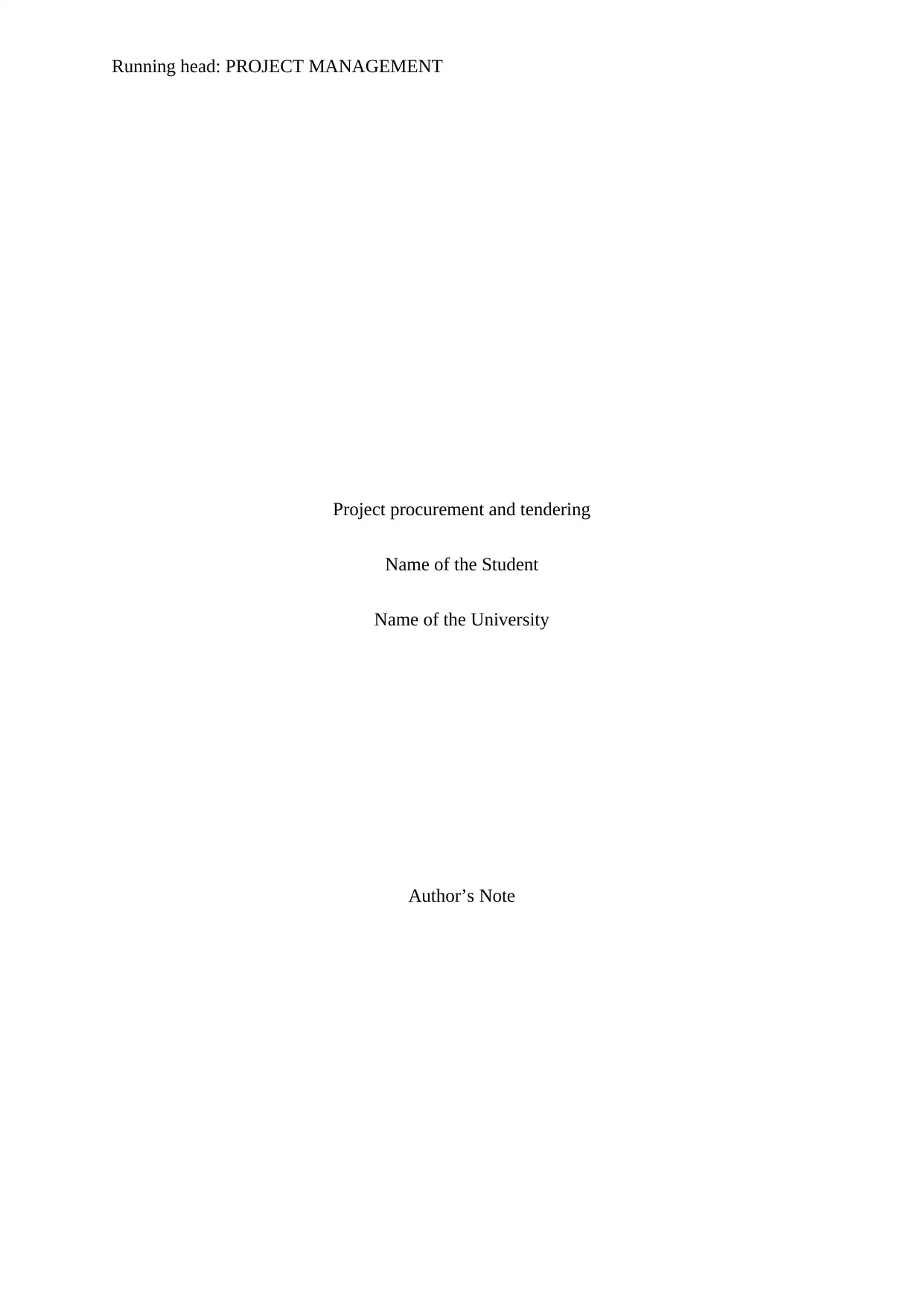
Running head: PROJECT MANAGEMENT
Project procurement and tendering
Name of the Student
Name of the University
Author’s Note
Project procurement and tendering
Name of the Student
Name of the University
Author’s Note
Paraphrase This Document
Need a fresh take? Get an instant paraphrase of this document with our AI Paraphraser
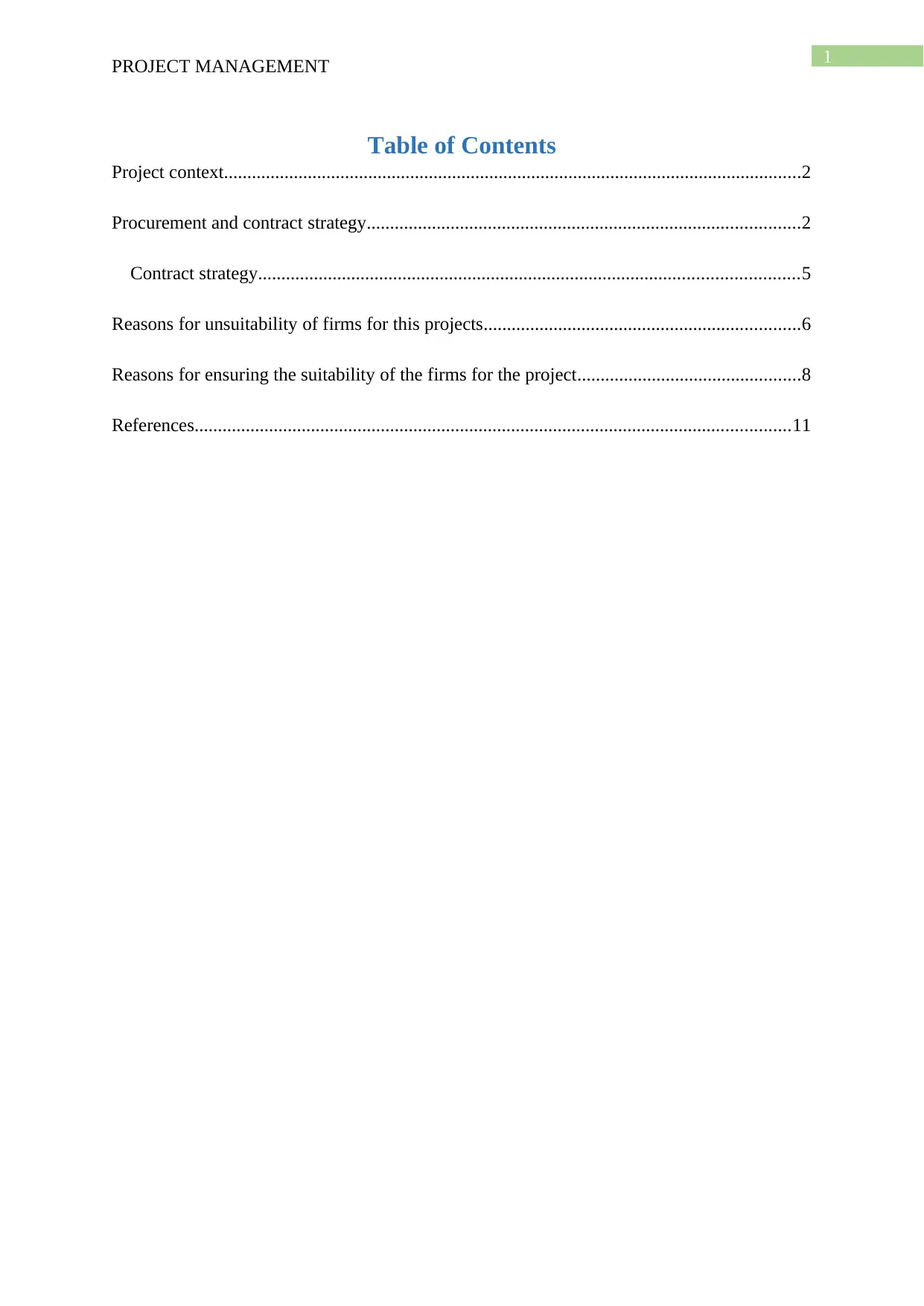
1
PROJECT MANAGEMENT
Table of Contents
Project context............................................................................................................................2
Procurement and contract strategy.............................................................................................2
Contract strategy....................................................................................................................5
Reasons for unsuitability of firms for this projects....................................................................6
Reasons for ensuring the suitability of the firms for the project................................................8
References................................................................................................................................11
PROJECT MANAGEMENT
Table of Contents
Project context............................................................................................................................2
Procurement and contract strategy.............................................................................................2
Contract strategy....................................................................................................................5
Reasons for unsuitability of firms for this projects....................................................................6
Reasons for ensuring the suitability of the firms for the project................................................8
References................................................................................................................................11
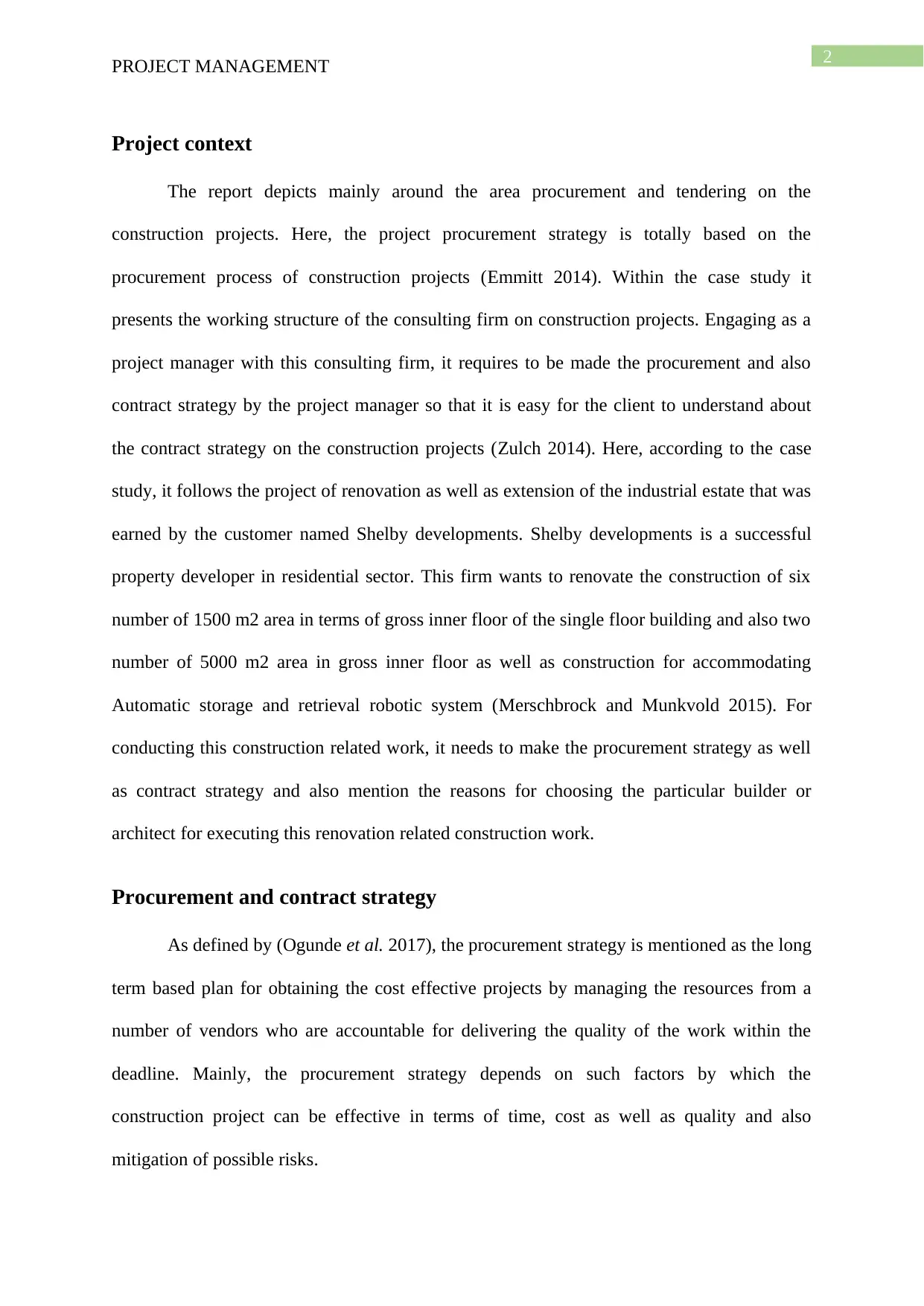
2
PROJECT MANAGEMENT
Project context
The report depicts mainly around the area procurement and tendering on the
construction projects. Here, the project procurement strategy is totally based on the
procurement process of construction projects (Emmitt 2014). Within the case study it
presents the working structure of the consulting firm on construction projects. Engaging as a
project manager with this consulting firm, it requires to be made the procurement and also
contract strategy by the project manager so that it is easy for the client to understand about
the contract strategy on the construction projects (Zulch 2014). Here, according to the case
study, it follows the project of renovation as well as extension of the industrial estate that was
earned by the customer named Shelby developments. Shelby developments is a successful
property developer in residential sector. This firm wants to renovate the construction of six
number of 1500 m2 area in terms of gross inner floor of the single floor building and also two
number of 5000 m2 area in gross inner floor as well as construction for accommodating
Automatic storage and retrieval robotic system (Merschbrock and Munkvold 2015). For
conducting this construction related work, it needs to make the procurement strategy as well
as contract strategy and also mention the reasons for choosing the particular builder or
architect for executing this renovation related construction work.
Procurement and contract strategy
As defined by (Ogunde et al. 2017), the procurement strategy is mentioned as the long
term based plan for obtaining the cost effective projects by managing the resources from a
number of vendors who are accountable for delivering the quality of the work within the
deadline. Mainly, the procurement strategy depends on such factors by which the
construction project can be effective in terms of time, cost as well as quality and also
mitigation of possible risks.
PROJECT MANAGEMENT
Project context
The report depicts mainly around the area procurement and tendering on the
construction projects. Here, the project procurement strategy is totally based on the
procurement process of construction projects (Emmitt 2014). Within the case study it
presents the working structure of the consulting firm on construction projects. Engaging as a
project manager with this consulting firm, it requires to be made the procurement and also
contract strategy by the project manager so that it is easy for the client to understand about
the contract strategy on the construction projects (Zulch 2014). Here, according to the case
study, it follows the project of renovation as well as extension of the industrial estate that was
earned by the customer named Shelby developments. Shelby developments is a successful
property developer in residential sector. This firm wants to renovate the construction of six
number of 1500 m2 area in terms of gross inner floor of the single floor building and also two
number of 5000 m2 area in gross inner floor as well as construction for accommodating
Automatic storage and retrieval robotic system (Merschbrock and Munkvold 2015). For
conducting this construction related work, it needs to make the procurement strategy as well
as contract strategy and also mention the reasons for choosing the particular builder or
architect for executing this renovation related construction work.
Procurement and contract strategy
As defined by (Ogunde et al. 2017), the procurement strategy is mentioned as the long
term based plan for obtaining the cost effective projects by managing the resources from a
number of vendors who are accountable for delivering the quality of the work within the
deadline. Mainly, the procurement strategy depends on such factors by which the
construction project can be effective in terms of time, cost as well as quality and also
mitigation of possible risks.
⊘ This is a preview!⊘
Do you want full access?
Subscribe today to unlock all pages.

Trusted by 1+ million students worldwide
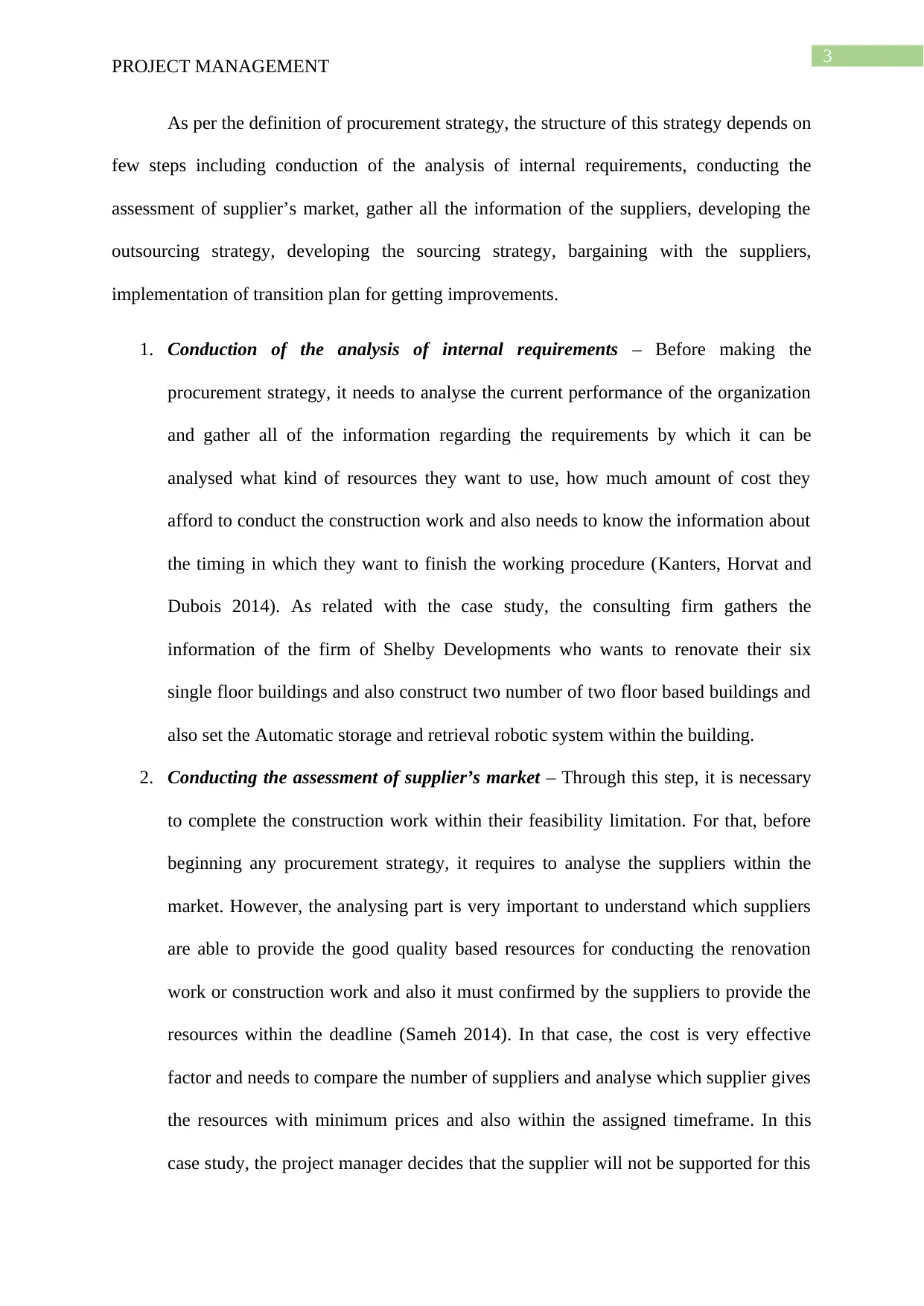
3
PROJECT MANAGEMENT
As per the definition of procurement strategy, the structure of this strategy depends on
few steps including conduction of the analysis of internal requirements, conducting the
assessment of supplier’s market, gather all the information of the suppliers, developing the
outsourcing strategy, developing the sourcing strategy, bargaining with the suppliers,
implementation of transition plan for getting improvements.
1. Conduction of the analysis of internal requirements – Before making the
procurement strategy, it needs to analyse the current performance of the organization
and gather all of the information regarding the requirements by which it can be
analysed what kind of resources they want to use, how much amount of cost they
afford to conduct the construction work and also needs to know the information about
the timing in which they want to finish the working procedure (Kanters, Horvat and
Dubois 2014). As related with the case study, the consulting firm gathers the
information of the firm of Shelby Developments who wants to renovate their six
single floor buildings and also construct two number of two floor based buildings and
also set the Automatic storage and retrieval robotic system within the building.
2. Conducting the assessment of supplier’s market – Through this step, it is necessary
to complete the construction work within their feasibility limitation. For that, before
beginning any procurement strategy, it requires to analyse the suppliers within the
market. However, the analysing part is very important to understand which suppliers
are able to provide the good quality based resources for conducting the renovation
work or construction work and also it must confirmed by the suppliers to provide the
resources within the deadline (Sameh 2014). In that case, the cost is very effective
factor and needs to compare the number of suppliers and analyse which supplier gives
the resources with minimum prices and also within the assigned timeframe. In this
case study, the project manager decides that the supplier will not be supported for this
PROJECT MANAGEMENT
As per the definition of procurement strategy, the structure of this strategy depends on
few steps including conduction of the analysis of internal requirements, conducting the
assessment of supplier’s market, gather all the information of the suppliers, developing the
outsourcing strategy, developing the sourcing strategy, bargaining with the suppliers,
implementation of transition plan for getting improvements.
1. Conduction of the analysis of internal requirements – Before making the
procurement strategy, it needs to analyse the current performance of the organization
and gather all of the information regarding the requirements by which it can be
analysed what kind of resources they want to use, how much amount of cost they
afford to conduct the construction work and also needs to know the information about
the timing in which they want to finish the working procedure (Kanters, Horvat and
Dubois 2014). As related with the case study, the consulting firm gathers the
information of the firm of Shelby Developments who wants to renovate their six
single floor buildings and also construct two number of two floor based buildings and
also set the Automatic storage and retrieval robotic system within the building.
2. Conducting the assessment of supplier’s market – Through this step, it is necessary
to complete the construction work within their feasibility limitation. For that, before
beginning any procurement strategy, it requires to analyse the suppliers within the
market. However, the analysing part is very important to understand which suppliers
are able to provide the good quality based resources for conducting the renovation
work or construction work and also it must confirmed by the suppliers to provide the
resources within the deadline (Sameh 2014). In that case, the cost is very effective
factor and needs to compare the number of suppliers and analyse which supplier gives
the resources with minimum prices and also within the assigned timeframe. In this
case study, the project manager decides that the supplier will not be supported for this
Paraphrase This Document
Need a fresh take? Get an instant paraphrase of this document with our AI Paraphraser

4
PROJECT MANAGEMENT
project. However, that supplier would be able to provide the resources within the
timeframe but the communication process of the supplier is very low. For this reason,
this supplier will not selected for this project.
3. Gather all the information of the suppliers – It is very significant part, to gather all
the information of the suppliers for construction project. The selection of the suppliers
depend on the criteria of them (Chien, Wu and Huang 2014). For collecting the
information, it is required to collect the data regarding the business performance of
the suppliers, financial statements as well as credit reports and also references.
According to possibility, it must visit the official website page of the suppliers for
getting more relevant information.
4. Developing the outsourcing strategy – Through this stage, after gathering
information from the stakeholders, it requires to select the exact strategy for collecting
resources. Mainly, in construction projects, there are three different kinds of
outsourcing strategy including direct purchase from the selected suppliers by sending
Request for Proposal (RFP), acquisition means the purchasing process of resources
from the desirable suppliers and the last one is related with the strategic partnership
which depicts the establishment of an agreement between the selected suppliers and
project manager.
5. Developing the sourcing strategy – After selection of suppliers and selecting the
outsourcing strategy, it requires to select the procurement process of collecting the
resources or materials for the construction work (Walker 2015). It needs to send the
Request for Proposal (RFP) to the suppliers for collecting the material within the
timeframe. The proposal should include the detailed information of the material as
well as production specifications, delivery related requirements, evaluating the criteria
PROJECT MANAGEMENT
project. However, that supplier would be able to provide the resources within the
timeframe but the communication process of the supplier is very low. For this reason,
this supplier will not selected for this project.
3. Gather all the information of the suppliers – It is very significant part, to gather all
the information of the suppliers for construction project. The selection of the suppliers
depend on the criteria of them (Chien, Wu and Huang 2014). For collecting the
information, it is required to collect the data regarding the business performance of
the suppliers, financial statements as well as credit reports and also references.
According to possibility, it must visit the official website page of the suppliers for
getting more relevant information.
4. Developing the outsourcing strategy – Through this stage, after gathering
information from the stakeholders, it requires to select the exact strategy for collecting
resources. Mainly, in construction projects, there are three different kinds of
outsourcing strategy including direct purchase from the selected suppliers by sending
Request for Proposal (RFP), acquisition means the purchasing process of resources
from the desirable suppliers and the last one is related with the strategic partnership
which depicts the establishment of an agreement between the selected suppliers and
project manager.
5. Developing the sourcing strategy – After selection of suppliers and selecting the
outsourcing strategy, it requires to select the procurement process of collecting the
resources or materials for the construction work (Walker 2015). It needs to send the
Request for Proposal (RFP) to the suppliers for collecting the material within the
timeframe. The proposal should include the detailed information of the material as
well as production specifications, delivery related requirements, evaluating the criteria
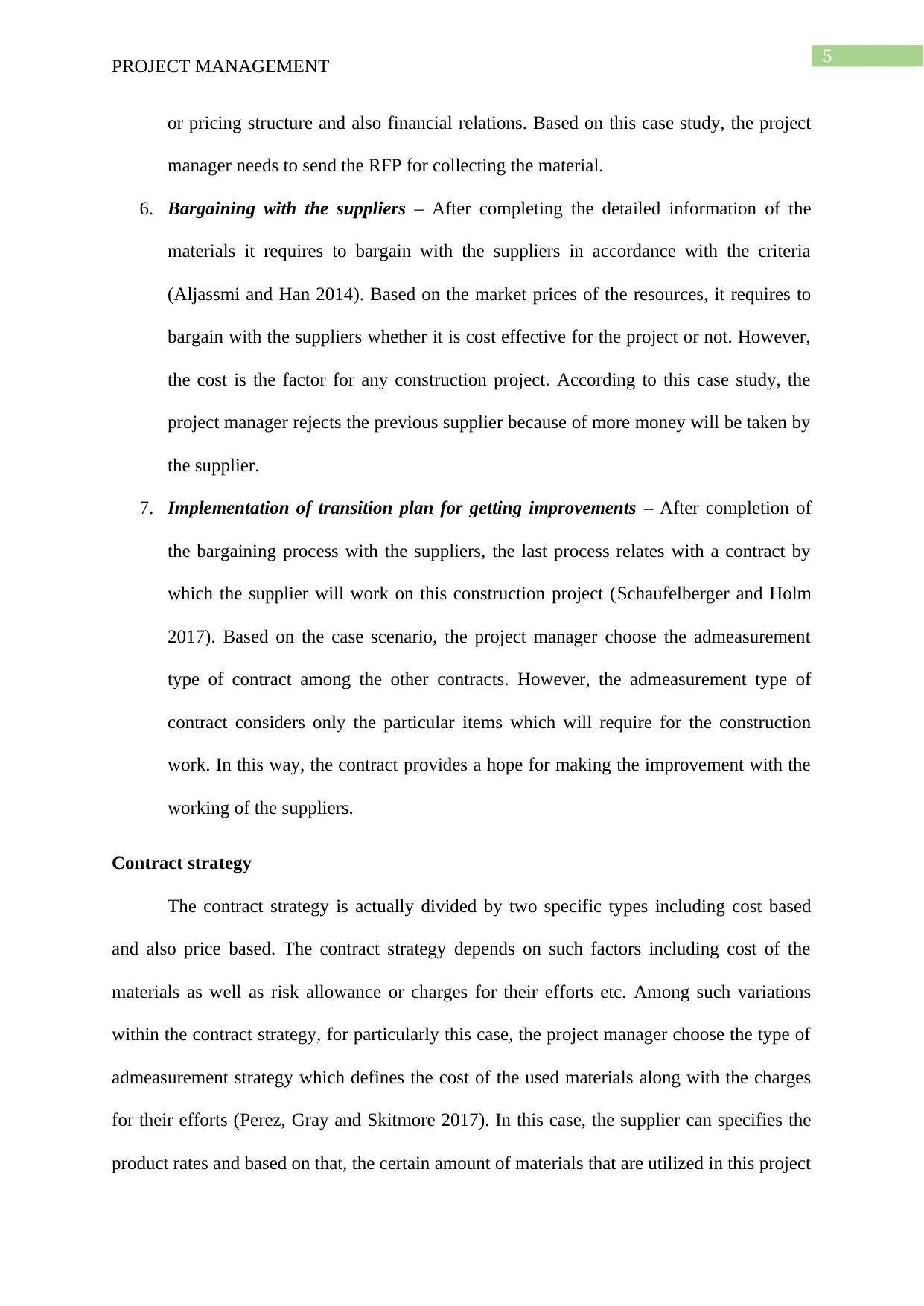
5
PROJECT MANAGEMENT
or pricing structure and also financial relations. Based on this case study, the project
manager needs to send the RFP for collecting the material.
6. Bargaining with the suppliers – After completing the detailed information of the
materials it requires to bargain with the suppliers in accordance with the criteria
(Aljassmi and Han 2014). Based on the market prices of the resources, it requires to
bargain with the suppliers whether it is cost effective for the project or not. However,
the cost is the factor for any construction project. According to this case study, the
project manager rejects the previous supplier because of more money will be taken by
the supplier.
7. Implementation of transition plan for getting improvements – After completion of
the bargaining process with the suppliers, the last process relates with a contract by
which the supplier will work on this construction project (Schaufelberger and Holm
2017). Based on the case scenario, the project manager choose the admeasurement
type of contract among the other contracts. However, the admeasurement type of
contract considers only the particular items which will require for the construction
work. In this way, the contract provides a hope for making the improvement with the
working of the suppliers.
Contract strategy
The contract strategy is actually divided by two specific types including cost based
and also price based. The contract strategy depends on such factors including cost of the
materials as well as risk allowance or charges for their efforts etc. Among such variations
within the contract strategy, for particularly this case, the project manager choose the type of
admeasurement strategy which defines the cost of the used materials along with the charges
for their efforts (Perez, Gray and Skitmore 2017). In this case, the supplier can specifies the
product rates and based on that, the certain amount of materials that are utilized in this project
PROJECT MANAGEMENT
or pricing structure and also financial relations. Based on this case study, the project
manager needs to send the RFP for collecting the material.
6. Bargaining with the suppliers – After completing the detailed information of the
materials it requires to bargain with the suppliers in accordance with the criteria
(Aljassmi and Han 2014). Based on the market prices of the resources, it requires to
bargain with the suppliers whether it is cost effective for the project or not. However,
the cost is the factor for any construction project. According to this case study, the
project manager rejects the previous supplier because of more money will be taken by
the supplier.
7. Implementation of transition plan for getting improvements – After completion of
the bargaining process with the suppliers, the last process relates with a contract by
which the supplier will work on this construction project (Schaufelberger and Holm
2017). Based on the case scenario, the project manager choose the admeasurement
type of contract among the other contracts. However, the admeasurement type of
contract considers only the particular items which will require for the construction
work. In this way, the contract provides a hope for making the improvement with the
working of the suppliers.
Contract strategy
The contract strategy is actually divided by two specific types including cost based
and also price based. The contract strategy depends on such factors including cost of the
materials as well as risk allowance or charges for their efforts etc. Among such variations
within the contract strategy, for particularly this case, the project manager choose the type of
admeasurement strategy which defines the cost of the used materials along with the charges
for their efforts (Perez, Gray and Skitmore 2017). In this case, the supplier can specifies the
product rates and based on that, the certain amount of materials that are utilized in this project
⊘ This is a preview!⊘
Do you want full access?
Subscribe today to unlock all pages.

Trusted by 1+ million students worldwide
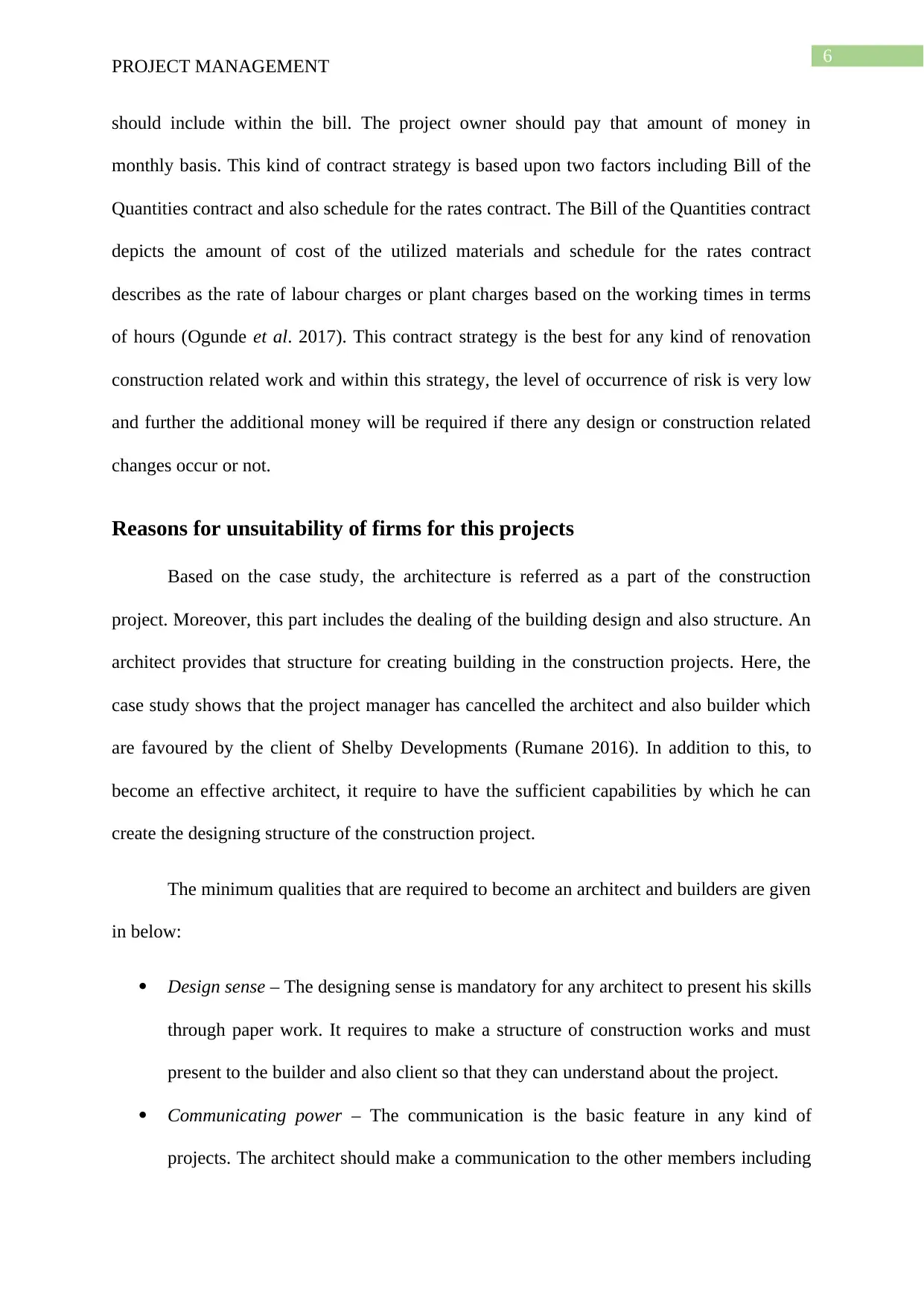
6
PROJECT MANAGEMENT
should include within the bill. The project owner should pay that amount of money in
monthly basis. This kind of contract strategy is based upon two factors including Bill of the
Quantities contract and also schedule for the rates contract. The Bill of the Quantities contract
depicts the amount of cost of the utilized materials and schedule for the rates contract
describes as the rate of labour charges or plant charges based on the working times in terms
of hours (Ogunde et al. 2017). This contract strategy is the best for any kind of renovation
construction related work and within this strategy, the level of occurrence of risk is very low
and further the additional money will be required if there any design or construction related
changes occur or not.
Reasons for unsuitability of firms for this projects
Based on the case study, the architecture is referred as a part of the construction
project. Moreover, this part includes the dealing of the building design and also structure. An
architect provides that structure for creating building in the construction projects. Here, the
case study shows that the project manager has cancelled the architect and also builder which
are favoured by the client of Shelby Developments (Rumane 2016). In addition to this, to
become an effective architect, it require to have the sufficient capabilities by which he can
create the designing structure of the construction project.
The minimum qualities that are required to become an architect and builders are given
in below:
Design sense – The designing sense is mandatory for any architect to present his skills
through paper work. It requires to make a structure of construction works and must
present to the builder and also client so that they can understand about the project.
Communicating power – The communication is the basic feature in any kind of
projects. The architect should make a communication to the other members including
PROJECT MANAGEMENT
should include within the bill. The project owner should pay that amount of money in
monthly basis. This kind of contract strategy is based upon two factors including Bill of the
Quantities contract and also schedule for the rates contract. The Bill of the Quantities contract
depicts the amount of cost of the utilized materials and schedule for the rates contract
describes as the rate of labour charges or plant charges based on the working times in terms
of hours (Ogunde et al. 2017). This contract strategy is the best for any kind of renovation
construction related work and within this strategy, the level of occurrence of risk is very low
and further the additional money will be required if there any design or construction related
changes occur or not.
Reasons for unsuitability of firms for this projects
Based on the case study, the architecture is referred as a part of the construction
project. Moreover, this part includes the dealing of the building design and also structure. An
architect provides that structure for creating building in the construction projects. Here, the
case study shows that the project manager has cancelled the architect and also builder which
are favoured by the client of Shelby Developments (Rumane 2016). In addition to this, to
become an effective architect, it require to have the sufficient capabilities by which he can
create the designing structure of the construction project.
The minimum qualities that are required to become an architect and builders are given
in below:
Design sense – The designing sense is mandatory for any architect to present his skills
through paper work. It requires to make a structure of construction works and must
present to the builder and also client so that they can understand about the project.
Communicating power – The communication is the basic feature in any kind of
projects. The architect should make a communication to the other members including
Paraphrase This Document
Need a fresh take? Get an instant paraphrase of this document with our AI Paraphraser
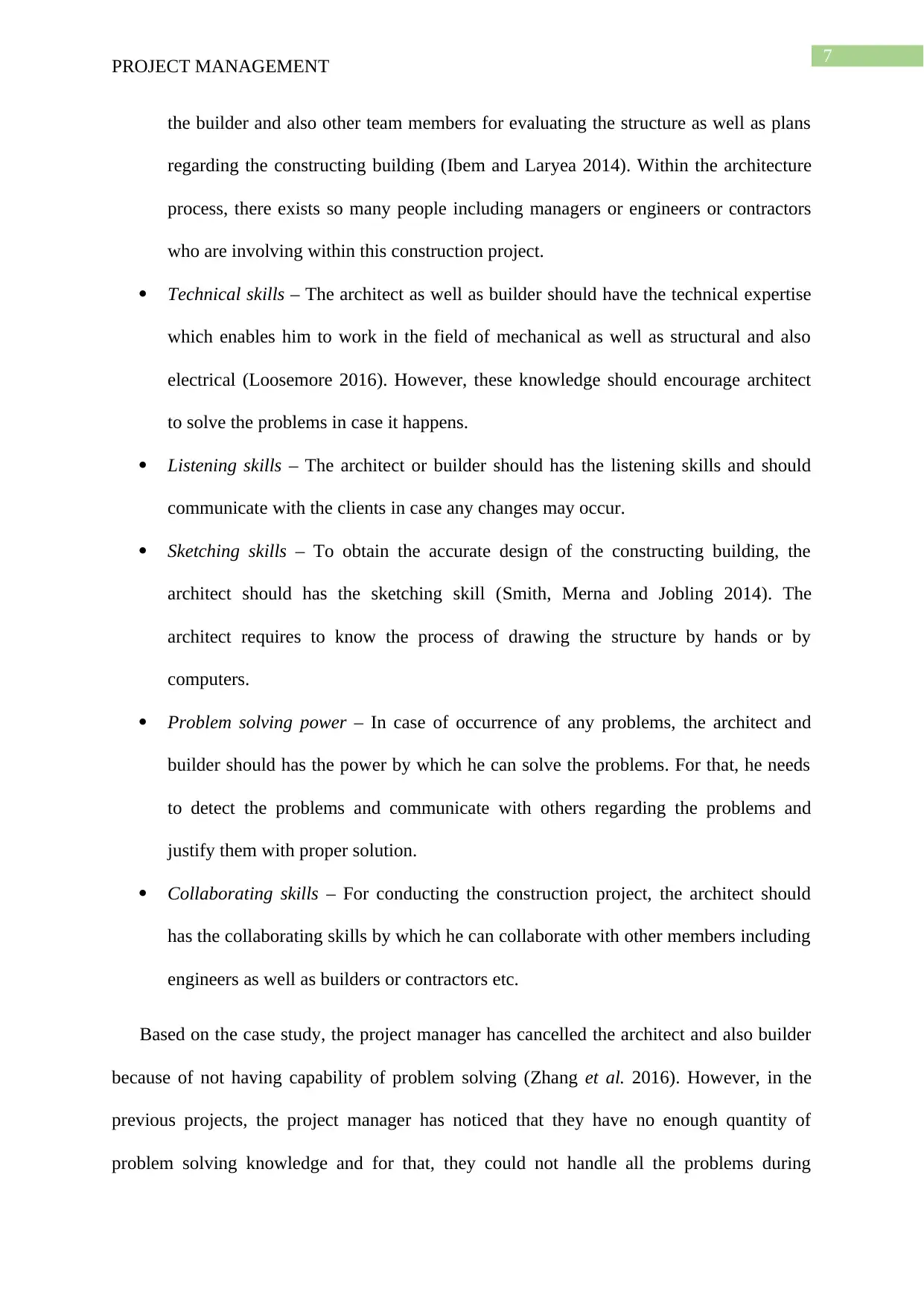
7
PROJECT MANAGEMENT
the builder and also other team members for evaluating the structure as well as plans
regarding the constructing building (Ibem and Laryea 2014). Within the architecture
process, there exists so many people including managers or engineers or contractors
who are involving within this construction project.
Technical skills – The architect as well as builder should have the technical expertise
which enables him to work in the field of mechanical as well as structural and also
electrical (Loosemore 2016). However, these knowledge should encourage architect
to solve the problems in case it happens.
Listening skills – The architect or builder should has the listening skills and should
communicate with the clients in case any changes may occur.
Sketching skills – To obtain the accurate design of the constructing building, the
architect should has the sketching skill (Smith, Merna and Jobling 2014). The
architect requires to know the process of drawing the structure by hands or by
computers.
Problem solving power – In case of occurrence of any problems, the architect and
builder should has the power by which he can solve the problems. For that, he needs
to detect the problems and communicate with others regarding the problems and
justify them with proper solution.
Collaborating skills – For conducting the construction project, the architect should
has the collaborating skills by which he can collaborate with other members including
engineers as well as builders or contractors etc.
Based on the case study, the project manager has cancelled the architect and also builder
because of not having capability of problem solving (Zhang et al. 2016). However, in the
previous projects, the project manager has noticed that they have no enough quantity of
problem solving knowledge and for that, they could not handle all the problems during
PROJECT MANAGEMENT
the builder and also other team members for evaluating the structure as well as plans
regarding the constructing building (Ibem and Laryea 2014). Within the architecture
process, there exists so many people including managers or engineers or contractors
who are involving within this construction project.
Technical skills – The architect as well as builder should have the technical expertise
which enables him to work in the field of mechanical as well as structural and also
electrical (Loosemore 2016). However, these knowledge should encourage architect
to solve the problems in case it happens.
Listening skills – The architect or builder should has the listening skills and should
communicate with the clients in case any changes may occur.
Sketching skills – To obtain the accurate design of the constructing building, the
architect should has the sketching skill (Smith, Merna and Jobling 2014). The
architect requires to know the process of drawing the structure by hands or by
computers.
Problem solving power – In case of occurrence of any problems, the architect and
builder should has the power by which he can solve the problems. For that, he needs
to detect the problems and communicate with others regarding the problems and
justify them with proper solution.
Collaborating skills – For conducting the construction project, the architect should
has the collaborating skills by which he can collaborate with other members including
engineers as well as builders or contractors etc.
Based on the case study, the project manager has cancelled the architect and also builder
because of not having capability of problem solving (Zhang et al. 2016). However, in the
previous projects, the project manager has noticed that they have no enough quantity of
problem solving knowledge and for that, they could not handle all the problems during
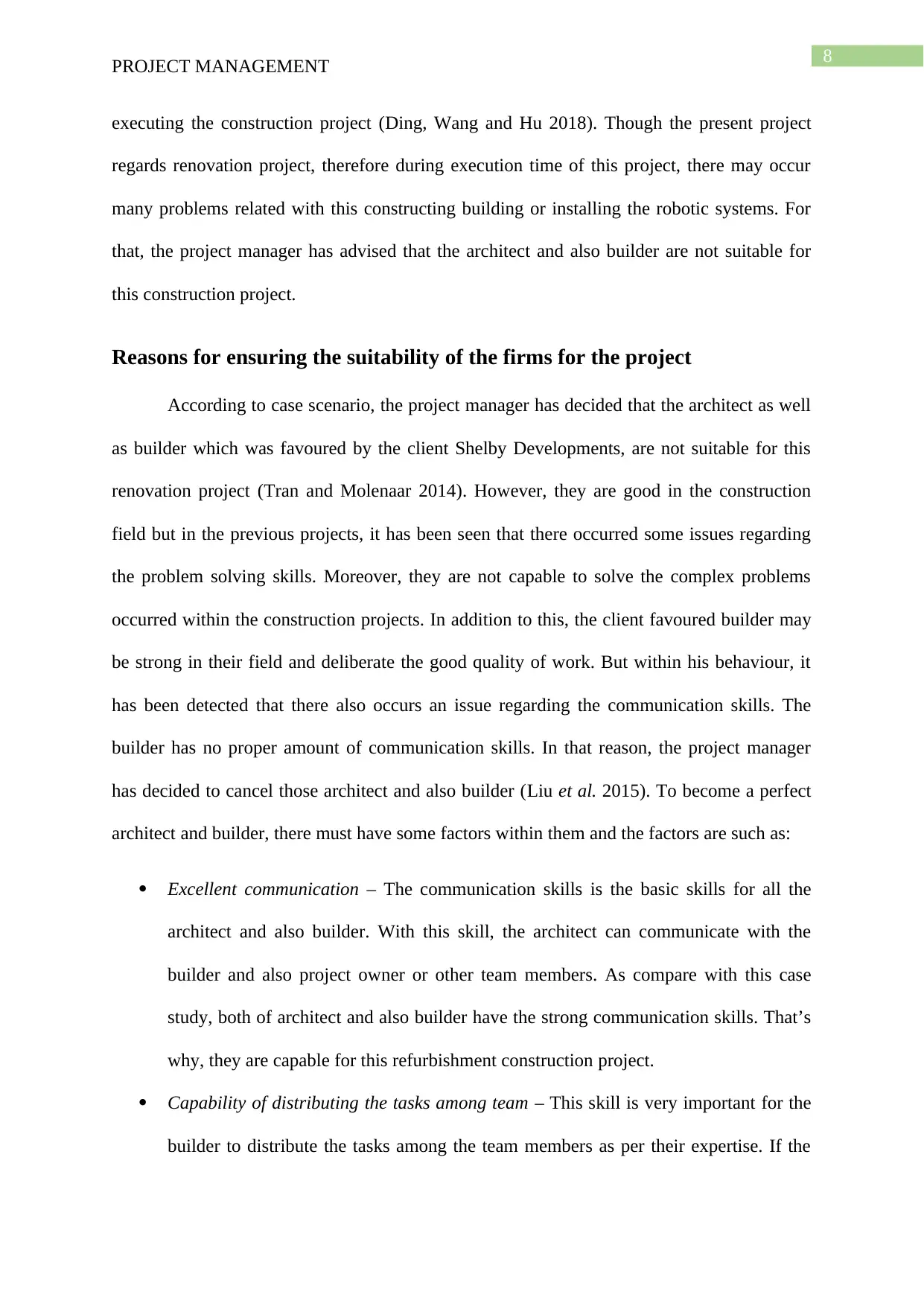
8
PROJECT MANAGEMENT
executing the construction project (Ding, Wang and Hu 2018). Though the present project
regards renovation project, therefore during execution time of this project, there may occur
many problems related with this constructing building or installing the robotic systems. For
that, the project manager has advised that the architect and also builder are not suitable for
this construction project.
Reasons for ensuring the suitability of the firms for the project
According to case scenario, the project manager has decided that the architect as well
as builder which was favoured by the client Shelby Developments, are not suitable for this
renovation project (Tran and Molenaar 2014). However, they are good in the construction
field but in the previous projects, it has been seen that there occurred some issues regarding
the problem solving skills. Moreover, they are not capable to solve the complex problems
occurred within the construction projects. In addition to this, the client favoured builder may
be strong in their field and deliberate the good quality of work. But within his behaviour, it
has been detected that there also occurs an issue regarding the communication skills. The
builder has no proper amount of communication skills. In that reason, the project manager
has decided to cancel those architect and also builder (Liu et al. 2015). To become a perfect
architect and builder, there must have some factors within them and the factors are such as:
Excellent communication – The communication skills is the basic skills for all the
architect and also builder. With this skill, the architect can communicate with the
builder and also project owner or other team members. As compare with this case
study, both of architect and also builder have the strong communication skills. That’s
why, they are capable for this refurbishment construction project.
Capability of distributing the tasks among team – This skill is very important for the
builder to distribute the tasks among the team members as per their expertise. If the
PROJECT MANAGEMENT
executing the construction project (Ding, Wang and Hu 2018). Though the present project
regards renovation project, therefore during execution time of this project, there may occur
many problems related with this constructing building or installing the robotic systems. For
that, the project manager has advised that the architect and also builder are not suitable for
this construction project.
Reasons for ensuring the suitability of the firms for the project
According to case scenario, the project manager has decided that the architect as well
as builder which was favoured by the client Shelby Developments, are not suitable for this
renovation project (Tran and Molenaar 2014). However, they are good in the construction
field but in the previous projects, it has been seen that there occurred some issues regarding
the problem solving skills. Moreover, they are not capable to solve the complex problems
occurred within the construction projects. In addition to this, the client favoured builder may
be strong in their field and deliberate the good quality of work. But within his behaviour, it
has been detected that there also occurs an issue regarding the communication skills. The
builder has no proper amount of communication skills. In that reason, the project manager
has decided to cancel those architect and also builder (Liu et al. 2015). To become a perfect
architect and builder, there must have some factors within them and the factors are such as:
Excellent communication – The communication skills is the basic skills for all the
architect and also builder. With this skill, the architect can communicate with the
builder and also project owner or other team members. As compare with this case
study, both of architect and also builder have the strong communication skills. That’s
why, they are capable for this refurbishment construction project.
Capability of distributing the tasks among team – This skill is very important for the
builder to distribute the tasks among the team members as per their expertise. If the
⊘ This is a preview!⊘
Do you want full access?
Subscribe today to unlock all pages.

Trusted by 1+ million students worldwide
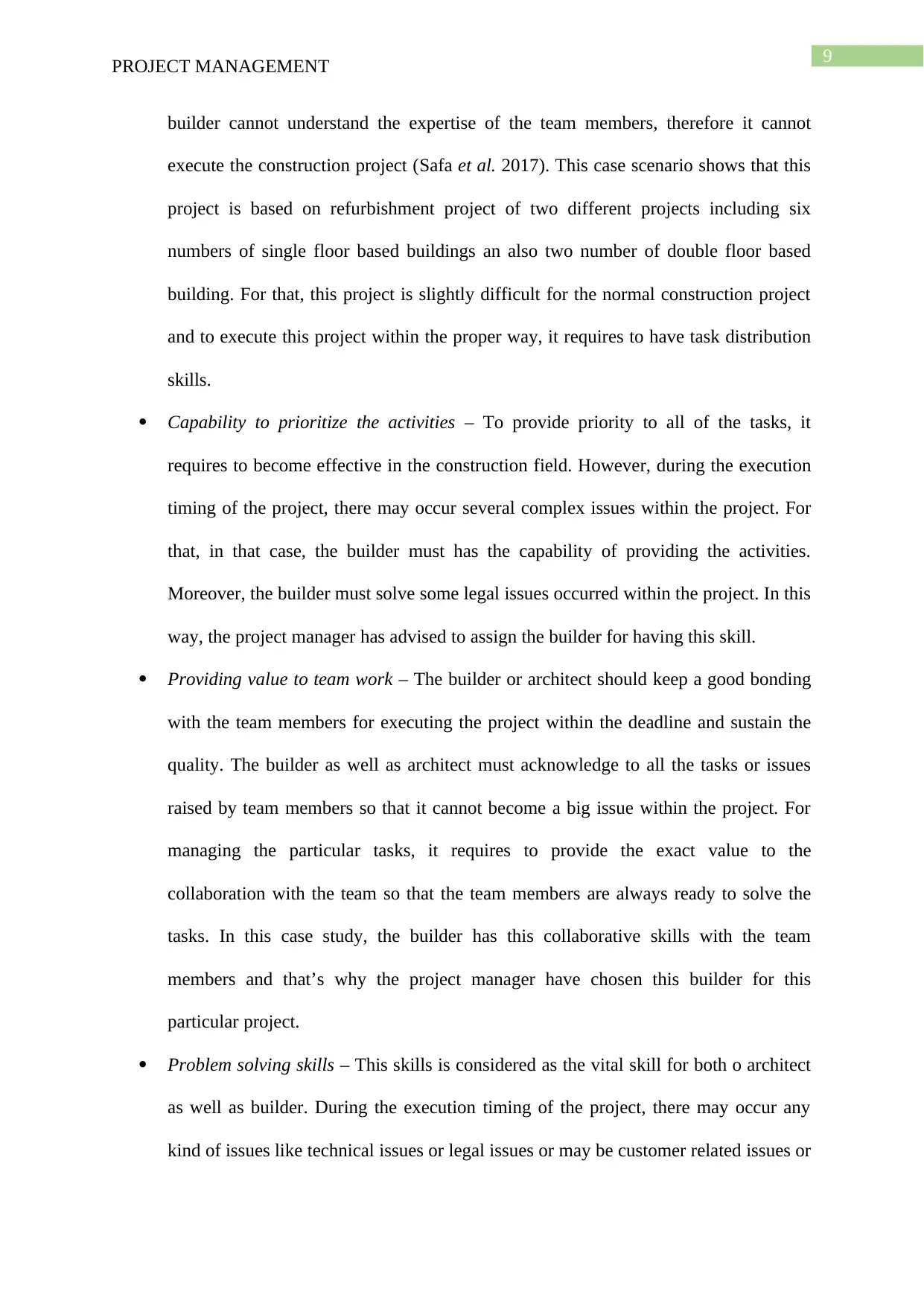
9
PROJECT MANAGEMENT
builder cannot understand the expertise of the team members, therefore it cannot
execute the construction project (Safa et al. 2017). This case scenario shows that this
project is based on refurbishment project of two different projects including six
numbers of single floor based buildings an also two number of double floor based
building. For that, this project is slightly difficult for the normal construction project
and to execute this project within the proper way, it requires to have task distribution
skills.
Capability to prioritize the activities – To provide priority to all of the tasks, it
requires to become effective in the construction field. However, during the execution
timing of the project, there may occur several complex issues within the project. For
that, in that case, the builder must has the capability of providing the activities.
Moreover, the builder must solve some legal issues occurred within the project. In this
way, the project manager has advised to assign the builder for having this skill.
Providing value to team work – The builder or architect should keep a good bonding
with the team members for executing the project within the deadline and sustain the
quality. The builder as well as architect must acknowledge to all the tasks or issues
raised by team members so that it cannot become a big issue within the project. For
managing the particular tasks, it requires to provide the exact value to the
collaboration with the team so that the team members are always ready to solve the
tasks. In this case study, the builder has this collaborative skills with the team
members and that’s why the project manager have chosen this builder for this
particular project.
Problem solving skills – This skills is considered as the vital skill for both o architect
as well as builder. During the execution timing of the project, there may occur any
kind of issues like technical issues or legal issues or may be customer related issues or
PROJECT MANAGEMENT
builder cannot understand the expertise of the team members, therefore it cannot
execute the construction project (Safa et al. 2017). This case scenario shows that this
project is based on refurbishment project of two different projects including six
numbers of single floor based buildings an also two number of double floor based
building. For that, this project is slightly difficult for the normal construction project
and to execute this project within the proper way, it requires to have task distribution
skills.
Capability to prioritize the activities – To provide priority to all of the tasks, it
requires to become effective in the construction field. However, during the execution
timing of the project, there may occur several complex issues within the project. For
that, in that case, the builder must has the capability of providing the activities.
Moreover, the builder must solve some legal issues occurred within the project. In this
way, the project manager has advised to assign the builder for having this skill.
Providing value to team work – The builder or architect should keep a good bonding
with the team members for executing the project within the deadline and sustain the
quality. The builder as well as architect must acknowledge to all the tasks or issues
raised by team members so that it cannot become a big issue within the project. For
managing the particular tasks, it requires to provide the exact value to the
collaboration with the team so that the team members are always ready to solve the
tasks. In this case study, the builder has this collaborative skills with the team
members and that’s why the project manager have chosen this builder for this
particular project.
Problem solving skills – This skills is considered as the vital skill for both o architect
as well as builder. During the execution timing of the project, there may occur any
kind of issues like technical issues or legal issues or may be customer related issues or
Paraphrase This Document
Need a fresh take? Get an instant paraphrase of this document with our AI Paraphraser
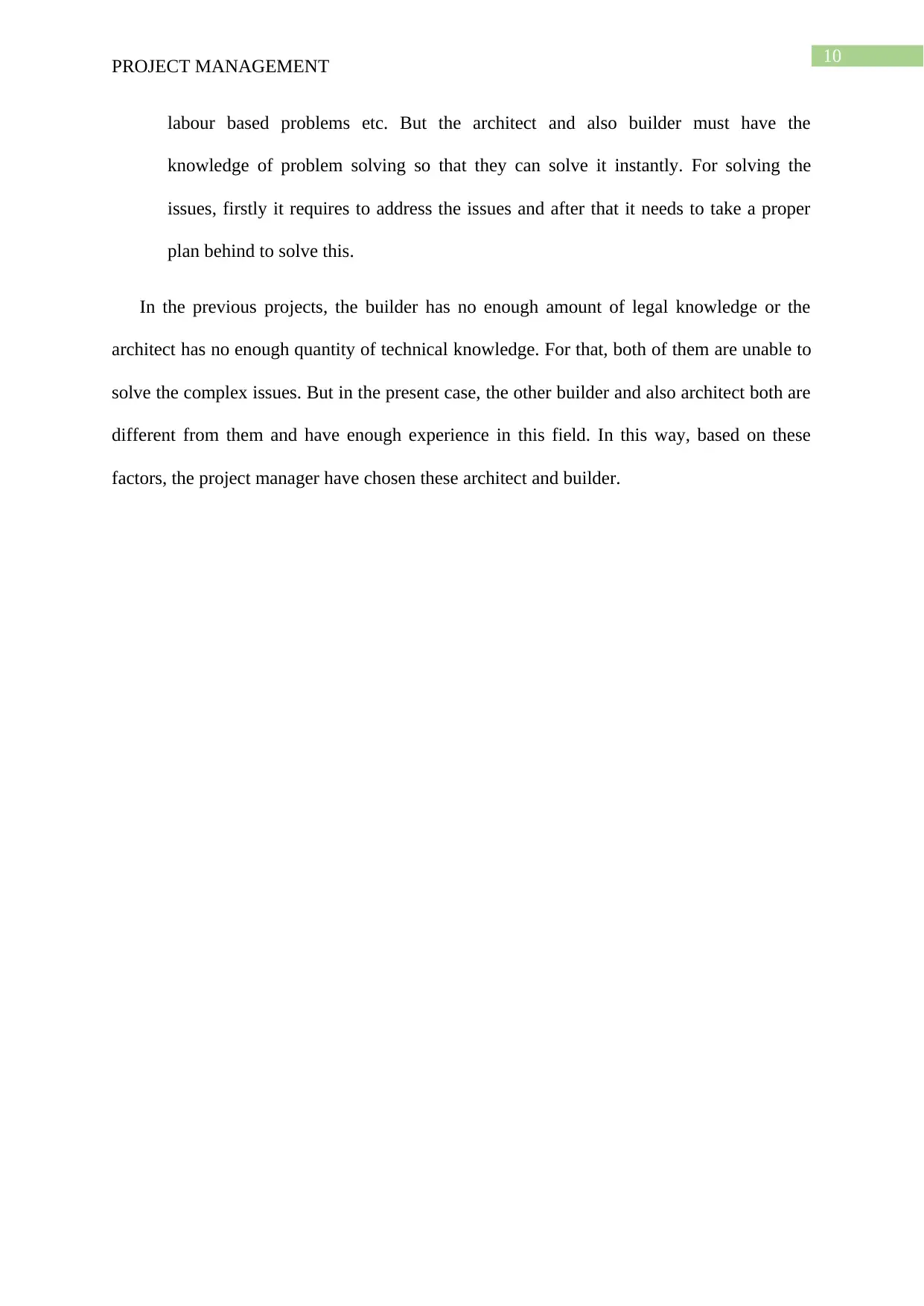
10
PROJECT MANAGEMENT
labour based problems etc. But the architect and also builder must have the
knowledge of problem solving so that they can solve it instantly. For solving the
issues, firstly it requires to address the issues and after that it needs to take a proper
plan behind to solve this.
In the previous projects, the builder has no enough amount of legal knowledge or the
architect has no enough quantity of technical knowledge. For that, both of them are unable to
solve the complex issues. But in the present case, the other builder and also architect both are
different from them and have enough experience in this field. In this way, based on these
factors, the project manager have chosen these architect and builder.
PROJECT MANAGEMENT
labour based problems etc. But the architect and also builder must have the
knowledge of problem solving so that they can solve it instantly. For solving the
issues, firstly it requires to address the issues and after that it needs to take a proper
plan behind to solve this.
In the previous projects, the builder has no enough amount of legal knowledge or the
architect has no enough quantity of technical knowledge. For that, both of them are unable to
solve the complex issues. But in the present case, the other builder and also architect both are
different from them and have enough experience in this field. In this way, based on these
factors, the project manager have chosen these architect and builder.
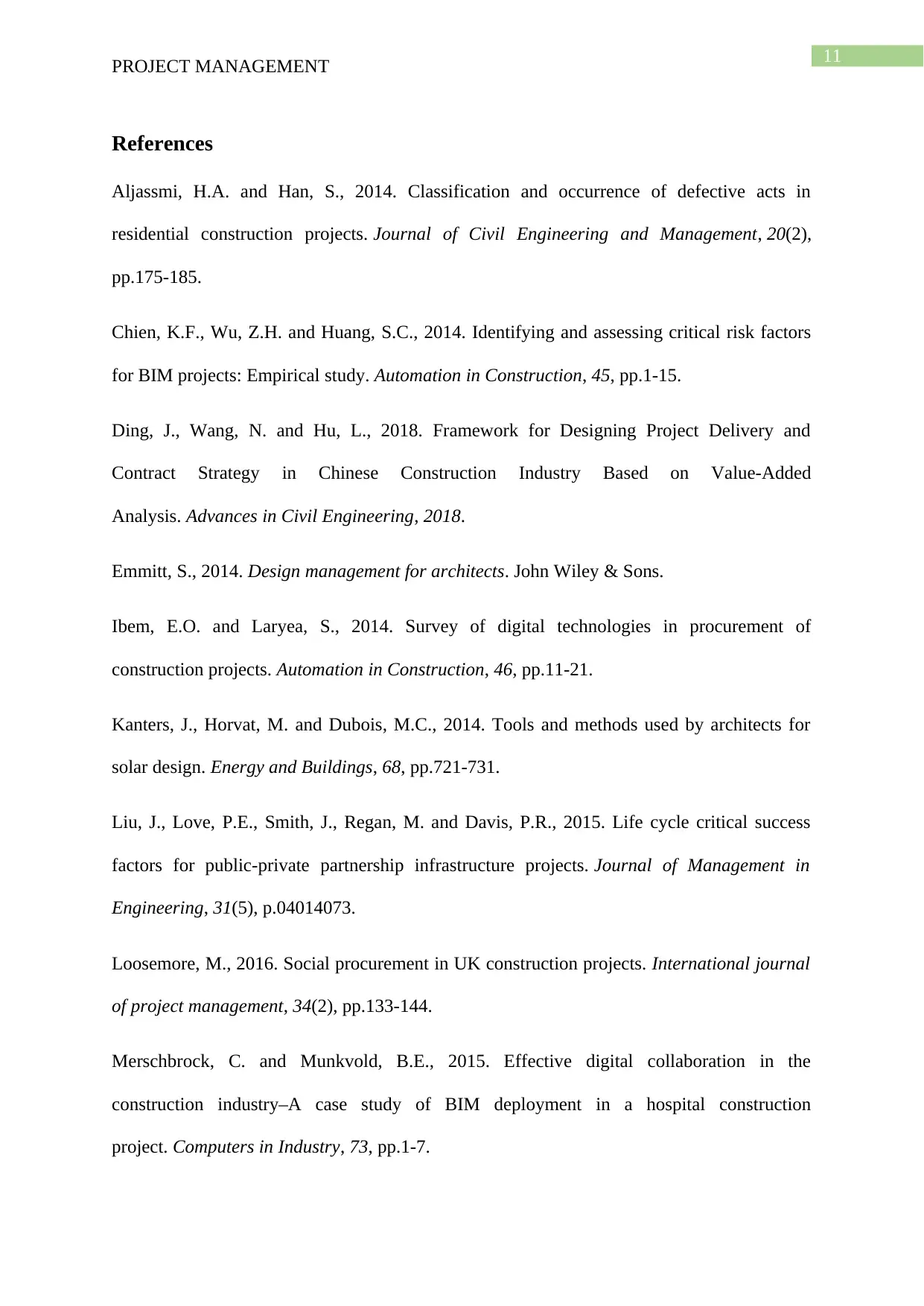
11
PROJECT MANAGEMENT
References
Aljassmi, H.A. and Han, S., 2014. Classification and occurrence of defective acts in
residential construction projects. Journal of Civil Engineering and Management, 20(2),
pp.175-185.
Chien, K.F., Wu, Z.H. and Huang, S.C., 2014. Identifying and assessing critical risk factors
for BIM projects: Empirical study. Automation in Construction, 45, pp.1-15.
Ding, J., Wang, N. and Hu, L., 2018. Framework for Designing Project Delivery and
Contract Strategy in Chinese Construction Industry Based on Value-Added
Analysis. Advances in Civil Engineering, 2018.
Emmitt, S., 2014. Design management for architects. John Wiley & Sons.
Ibem, E.O. and Laryea, S., 2014. Survey of digital technologies in procurement of
construction projects. Automation in Construction, 46, pp.11-21.
Kanters, J., Horvat, M. and Dubois, M.C., 2014. Tools and methods used by architects for
solar design. Energy and Buildings, 68, pp.721-731.
Liu, J., Love, P.E., Smith, J., Regan, M. and Davis, P.R., 2015. Life cycle critical success
factors for public-private partnership infrastructure projects. Journal of Management in
Engineering, 31(5), p.04014073.
Loosemore, M., 2016. Social procurement in UK construction projects. International journal
of project management, 34(2), pp.133-144.
Merschbrock, C. and Munkvold, B.E., 2015. Effective digital collaboration in the
construction industry–A case study of BIM deployment in a hospital construction
project. Computers in Industry, 73, pp.1-7.
PROJECT MANAGEMENT
References
Aljassmi, H.A. and Han, S., 2014. Classification and occurrence of defective acts in
residential construction projects. Journal of Civil Engineering and Management, 20(2),
pp.175-185.
Chien, K.F., Wu, Z.H. and Huang, S.C., 2014. Identifying and assessing critical risk factors
for BIM projects: Empirical study. Automation in Construction, 45, pp.1-15.
Ding, J., Wang, N. and Hu, L., 2018. Framework for Designing Project Delivery and
Contract Strategy in Chinese Construction Industry Based on Value-Added
Analysis. Advances in Civil Engineering, 2018.
Emmitt, S., 2014. Design management for architects. John Wiley & Sons.
Ibem, E.O. and Laryea, S., 2014. Survey of digital technologies in procurement of
construction projects. Automation in Construction, 46, pp.11-21.
Kanters, J., Horvat, M. and Dubois, M.C., 2014. Tools and methods used by architects for
solar design. Energy and Buildings, 68, pp.721-731.
Liu, J., Love, P.E., Smith, J., Regan, M. and Davis, P.R., 2015. Life cycle critical success
factors for public-private partnership infrastructure projects. Journal of Management in
Engineering, 31(5), p.04014073.
Loosemore, M., 2016. Social procurement in UK construction projects. International journal
of project management, 34(2), pp.133-144.
Merschbrock, C. and Munkvold, B.E., 2015. Effective digital collaboration in the
construction industry–A case study of BIM deployment in a hospital construction
project. Computers in Industry, 73, pp.1-7.
⊘ This is a preview!⊘
Do you want full access?
Subscribe today to unlock all pages.

Trusted by 1+ million students worldwide
1 out of 14
Related Documents
Your All-in-One AI-Powered Toolkit for Academic Success.
+13062052269
info@desklib.com
Available 24*7 on WhatsApp / Email
![[object Object]](/_next/static/media/star-bottom.7253800d.svg)
Unlock your academic potential
Copyright © 2020–2026 A2Z Services. All Rights Reserved. Developed and managed by ZUCOL.





